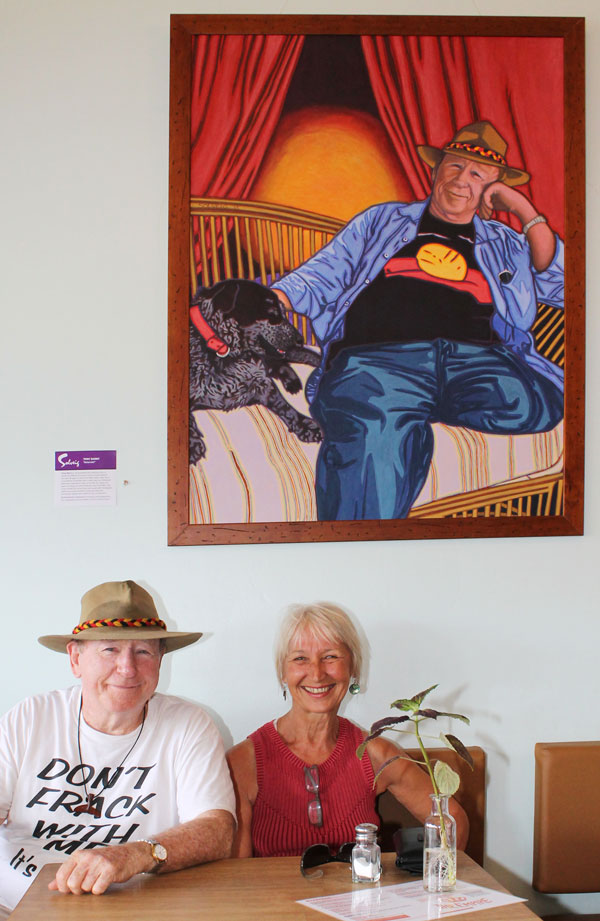“I have always been an artist” –Solveig

Solveig with iconic Australian actorvist Tony Barry
Further reading
The early years
From a young age, Solveig sat and observed the world around her, the people, life, herself. She was fascinated with the way we represent the world to ourselves, through symbols, icons, images and words. Both visual and auditory media were incredibly stimulating and fascinating to the young artist. She played many games, enjoyed lots of creative play, writing and drawing.
Her passion for creative pursuits saw her through high school with a scholarship to the National Art School in Sydney. Solveig relished the wonderful, mind-bending student life. Four years of a Diploma of Painting and Sculpture flew past.
She indulged in the total artist’s experience. Deep in bohemian burlesque and cabaret life, engaging in colourful, creative self-expression. She lived the peak of the psychedelic era with lecturers like Martin Sharp, John Olsen, Ken Reinhard, the elite artists of those times.
Life’s little detours
Soon after college, Solveig closed the chapter on her wondrous, open-ended, free and expressive, abundantly creative life. And started a new chapter: mothering her three boys. As they grew up and into manhood, she stole stole moments to be creative and follow her artistic bent. The taxation department called ‘Art’ a hobby so Solveig carried out more “responsible” work.
She became a psychologist and a hypnotherapist, gaining insights into the human condition. She sought wisdom around how we behave and think, and why we do the strange things we do. Again, Solveig found inspiration. A stream of creative expression burst forth and the Healing Journey Series was born.
An artist reborn
Since 2000, Solveig is a unstoppable creative force, living a joyful life, mirroring her times and environment. Everyday, she commits herself to being an artist, practicing her craft, honing her graphic impressionist style and creating the beautiful nature-inspired originals that fill her gallery.
Artistic process
Solveig takes her camera everywhere looking for scenes, elements, textures that inspire her. It may be a beautiful natural form or landscape, a colour scheme, the twinkle in an eye. It might be the way diverse elements juxtapose to express a particular view on life.
Whenever subject matter inspires her, Solveig goes into the trance-like state of translating it into her graphic impressionist style. Once she is clear and has mapped out the colours and procedure, Solveig projects it from her computer using a digital projector onto a flat surface board that is primed and sealed on both sides.
Solveig sketches a basic outline drawing of the elements of the composition using a flat square brush so that she has the range of thick and thin lines.
Then the fun begins
Once mapped out, Solveig roughly fills in the first layer of colours. These will end up being edge colours. The second layer of colour inset into the base colours leaving an edge that will be complementary, usually, to the first layer. She continue this way for up to four levels, building the illusion of form and details as she goes. At level four, something amazing emerges and Solveig knows she has arrived at the result she envisaged in the first place.
Because Solveig have painted so many works, her skills and instincts are trustworthy and have become subconscious. Her process from beginning to end is like a meditation: very present, loving, joyful and channelling co-creation.
Once complete and signed, Solveig seals with a varnish. Her choice is always a matte varnish because she doesn’t want a reflective surface. Solveig would prefer people felt they could walk right in to the scene or composition, sit down and feel the energy.
How Solveig’s style developed
Solveig’s style developed when she became infatuated with colour, both visually and psychologically. She looked at the artists that most excited her with their palette. The Impressionists and the post Impressionists won her over and she applied their colour theory to her work. Instead of painterly dabs of colour, Solveig chose to work in shapes of colour, bringing a more graphic effect to the impressionist manifesto.
Solveig’s advice to artist starting out
Begin. Always have something in the background that is exploring your creativity, channeling your self expression. No matter how part time your relationship with your creativity is, always have a project that is challenging you, teaching you, training your hand-eye skills and showing you what you really want to do and be.
Life will call on your time and energy with duties and responsibilities to others and society, and it will be hard to justify the joy and satisfaction your creative work gives you. In time though you will have practiced your craft enough to be brilliant and then you can truly shine.
Solveig’s work
Solveig’s work is richly colourful and energetic. Not in a frenetic way, but alive and vibrating with the contradictions of colour combinations. Nature is Solveig’s focus and muse, and once inspired, Solveig designs the visual representation that will best express that co-creation. Nature is beautiful, calming, healing and meditative. She is also dramatic and thought-provoking.
